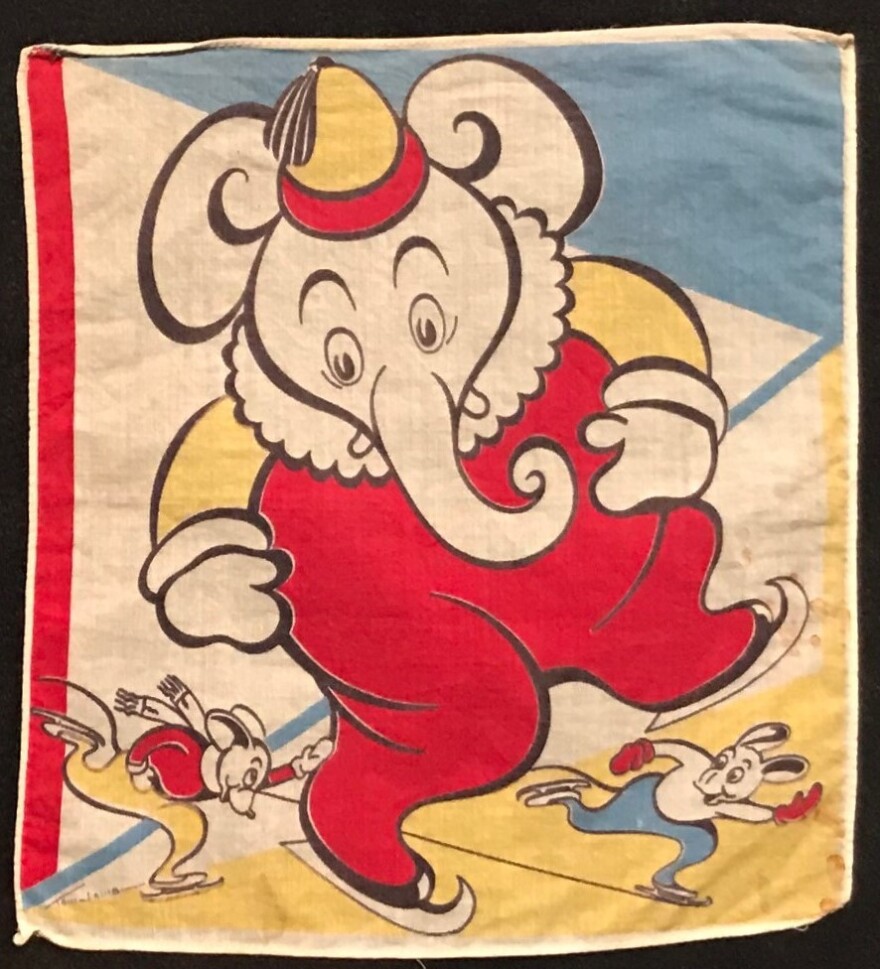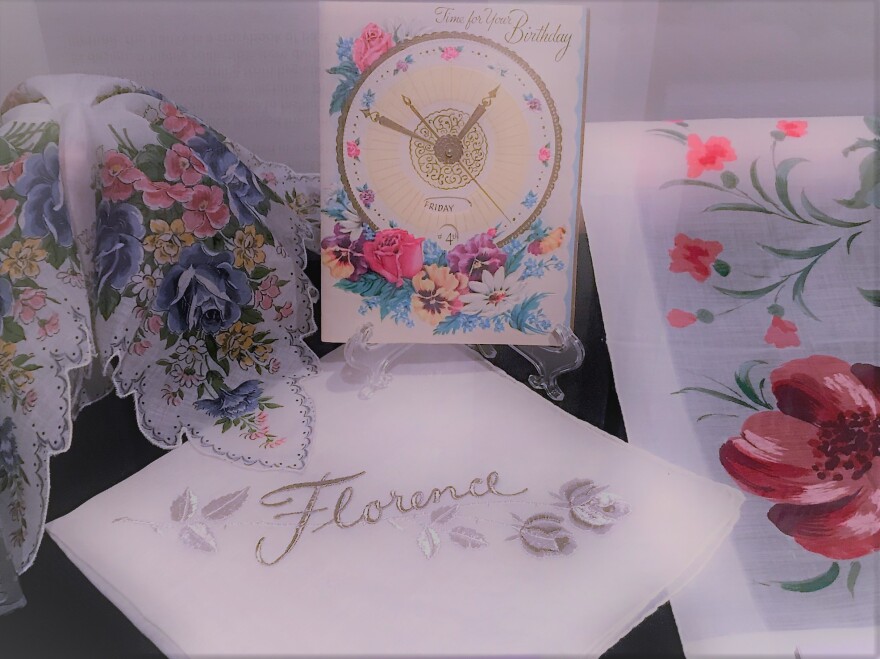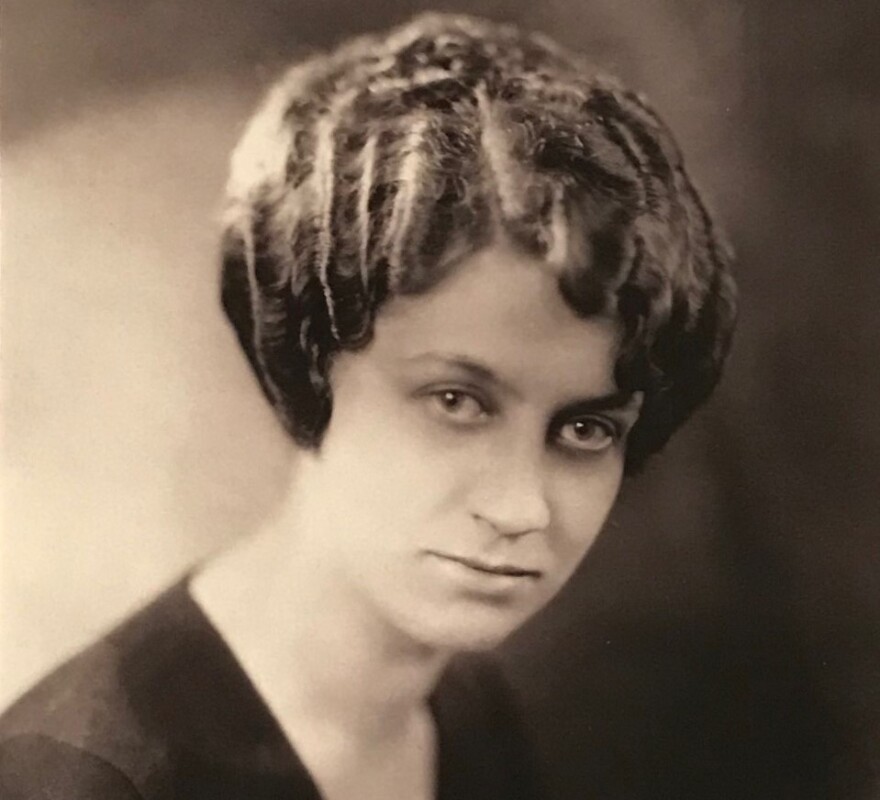In the early 1990s, a man donated several boxes to Colorado State UniversityŌĆÖs Department of Design and Merchandising. In them were more than 1,100 handkerchiefs collected by his recently deceased aunt.
At the time, the handkerchiefs were cataloged and placed in storage. Over time, the details of their arrival were lost -- until two volunteers decided to unravel the mystery.
It started as an average assignment, said Marcella Wells, a volunteer with .
ŌĆ£For about seven weeks, we sat as a team and accessioned every single one of them -- which meant touching every one of them, taking it out of its box, opening it up, writing a written description, tagging it with a number and then photographing it.ŌĆØ
The ŌĆ£weŌĆØ that Wells is talking about includes fellow volunteer Terrie Cornell. And the items sheŌĆÖs referring to are handkerchiefs, 1,107 of them collected from between 1938 through the early 1970s.

The collection included hankies of almost every conceivable type and for every occasion. Black ones for funerals. Festive ones for holidays. Commemorative hankies for the Rose Bowl and the 1962 Seattle WorldŌĆÖs Fair.
The collection had resurfaced when the museum moved into its new facility at the University Center for the Arts in 2016, said museum curator Katie Knowles.

The collectionŌĆÖs size, along with the diversity of styles and fabrics, made it unique, Knowles said. Not to mention the fact that the handkerchief was now a symbol of a bygone era.
ŌĆ£ItŌĆÖs something that is really recognizable to people, even though we donŌĆÖt use them personally anymore,ŌĆØ she said. ŌĆ£A lot of people remember their mother or their grandmother using handkerchiefs.ŌĆØ
As they went through the boxes, Wells said they began to create a mental picture of who owned these handkerchiefs.
ŌĆ£I just envisioned a typical 1950s -- ŌĆś40s, ŌĆś50s -- housewife,ŌĆØ she said.

Obviously, this was a woman who loved handkerchiefs. She was even a member of the Hanky of the Month Club, a subscription service for handkerchiefs that was popular in the 1940s and ŌĆś50s. She was probably also sentimental. Many hankies in the collection included cards indicating they were gifts -- including a number from ŌĆ£Ed,ŌĆØ who they believed was her husband.
ŌĆ£To me, a collection like this from friends and family, would have meant something really heartwarming,ŌĆØ Wells said.
The one thing they didnŌĆÖt have: the original ownerŌĆÖs full name. The only clue was a monogram on many of the handkerchiefs: ŌĆ£Florence.ŌĆØ

ŌĆ£When she kept meticulous records of who gave her what, and when -- she never kept an envelope with these cards,ŌĆØ Terrie Cornell said. ŌĆ£She kept the cards -- theyŌĆÖre lovely -- but not the envelopes. It was very frustrating.ŌĆØ
It was a strange feeling going through the handkerchiefs and not having a full-name or a face to put with them, Cornell said. They desperately wanted more information, but too much time had passed. No one at the museum knew anything about the mystery man who dropped off the boxes back in the early 1990s.
After weeks of scouring through the collection, Cornell took one last look through the boxes.
And then she saw it: A lone envelope addressed to Florence Luebke.

ŌĆ£Luckily her name wasnŌĆÖt Smith or Jones,ŌĆØ Cornell laughed. ŌĆ£I rushed home to my genealogical sources online and plugged her into Ancestry and Family Search, and bam! Up she came.ŌĆØ
Florence Luebke was a file clerk from Chicago. The daughter of German immigrants, she had three sisters and one brother. And while Cornell and Wells were wrong about Ed -- Luebke never married or had children -- they were right about one thing: She was very loved.
ŌĆ£She was fierce, and she was fearless,ŌĆØ said Pat Gilbert OŌĆÖNeill, LuebkeŌĆÖs grandniece.
OŌĆÖNeillŌĆÖs father, Paul Gilbert, had been a physical education professor at CSU. He also was the mystery man who donated LuebkeŌĆÖs collection to the museum all those years ago.
Luebke died in 1985 after moving to Fort Collins in the 1970s to be close to her family. Gilbert, who passed away in 2015, had been the keeper of many of the family heirlooms. OŌĆÖNeill said it was just like her father to find the best possible home for her auntŌĆÖs collection.

ŌĆ£I think that was wonderful of my dad to donate the handkerchiefs to the museum, which would truly appreciate this donation of textiles,ŌĆØ OŌĆÖNeill said.
After being contacted by the museum, OŌĆÖNeill helped fill in the gaps about ŌĆ£Auntie Flo,ŌĆØ as she called her.

Luebke was a ŌĆ£fierce and fearlessŌĆØ career woman who blazed her own trail at a time when options were limited for women, she said. She loved riding roller coasters, even into her 70s. She was generous and kind and loved her family, particularly her three sisters, who vacationed together every summer and posed in their birth order for every photo. In fact, the ŌĆ£EdŌĆØ referenced in the cards was not a paramour, but a nickname for her older sister, Esther,
The handkerchiefs? Those were a mystery to OŌĆÖNeill, who never remembered seeing them displayed. As a teen, OŌĆÖNeill said she did see a large stack of boxes in her auntŌĆÖs tiny studio apartment. Luebke told her they were full of her ŌĆ£treasures.ŌĆØ
ŌĆ£I didnŌĆÖt realize at the time that it probably was -- a lot of it was handkerchiefs,ŌĆØ she said.
OŌĆÖNeill also shared photos of Florence that are now part of the Avenir MuseumŌĆÖs latest exhibit, ŌĆ£Nothing to Sneeze At: One Woman - 1,107 Hankies.ŌĆØ
ŌĆ£What this exhibit really does well is talks about the history of the hankie as an object, but then when we figured out who Florence was, we also get to tell the story of who this particular hankie collector was, and how this collection represents her story,ŌĆØ said museum curator Knowles.
Luebke was a single woman, living in a big city on her own, she said. She kept family and friends close through these handkerchiefs.
ItŌĆÖs not often that single donations come with so much documentation, Knowles said. That fact is also pretty telling about how detail-oriented Luebke was.
ŌĆ£Well, she was a file clerk,ŌĆØ she said. ŌĆ£I mean, she took her work home with her. I guess she really liked filing.ŌĆØ
For Wells, who curated the exhibition, working with the collection has given her a greater appreciation of an item she didnŌĆÖt really give much thought to before.
ŌĆ£When I see a hankie now in a thrift store or a vintage collection, I always spend an extra few seconds with it because -- that meant something to someone at some point.ŌĆØ
"" is on display at the Avenir Museum at Colorado State University's University Center for the Arts through August 2018.






